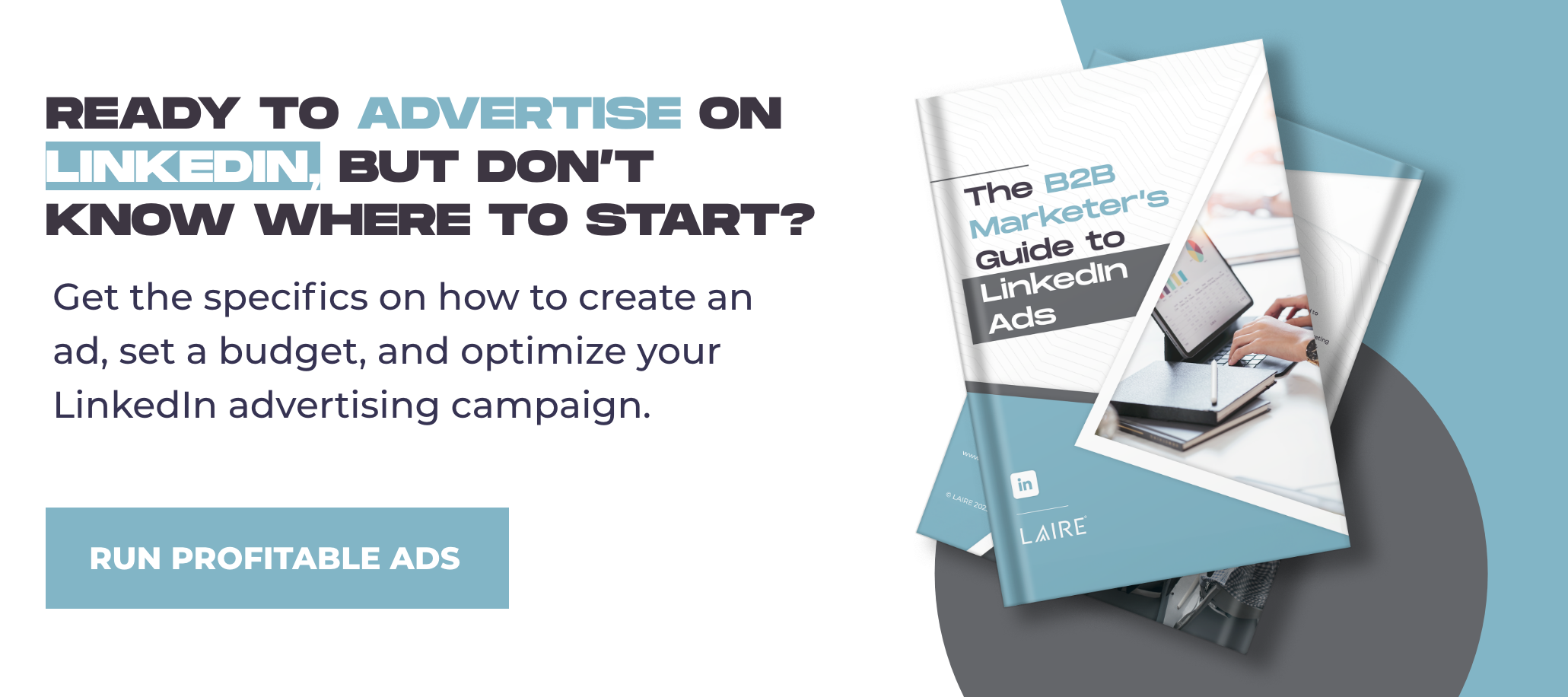If you’re trying to reach business professionals online, LinkedIn is the number one channel to get to them effectively.
You may have already gone into your LinkedIn Campaign Manager and created an ad that was not successful. Why is that? While your ad design is important, it’s not the number one criterion when creating your ad. You also have to pay attention to your targeting criteria and what you are testing
Read further to discover the best practices for how to create ads on LinkedIn.
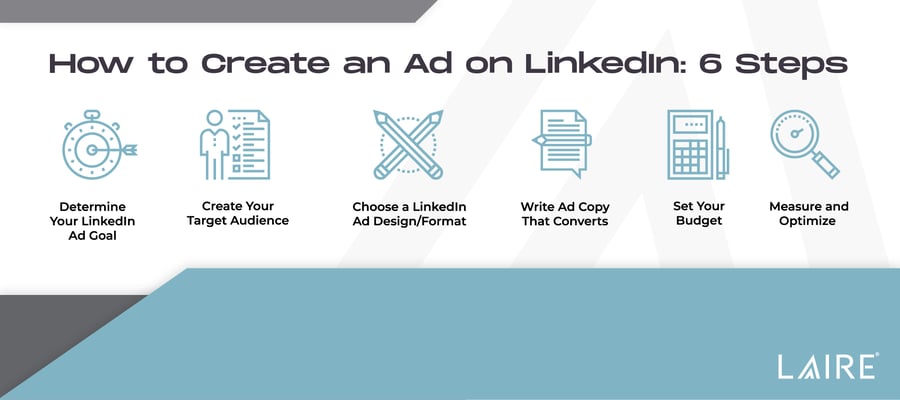
1. Determine Your LinkedIn Ad Goal
Before you create a LinkedIn ad campaign, you need to know your goal. Your goal can be anything from increasing brand awareness to increasing form submissions.
LinkedIn will also prompt you to select a goal from the following:
- Increase Brand Awareness: Get more people to know your brand through impression-based campaigns.
- Increase Website Traffic: Get more people to visit a website.
- Increase Engagement: Drive clicks, social actions, and company page follows.
- Increase Video Views: Tell your product or business story through video.
- Increase Lead Generation: Get leads using forms pre-filled with LinkedIn member information.
- Website Conversions: Drive valuable action on your website such as collecting leads or downloading ebooks.
- Hire Job Applicants: Promote job opportunities at your company.
![[ROPS] How to Create LinkedIn Ads- Designing a Killer Ad_Graphic 2 Freepik](https://www.lairedigital.com/hs-fs/hubfs/%5BROPS%5D%20How%20to%20Create%20LinkedIn%20Ads-%20Designing%20a%20Killer%20Ad_Graphic%202%20Freepik.png?width=900&height=400&name=%5BROPS%5D%20How%20to%20Create%20LinkedIn%20Ads-%20Designing%20a%20Killer%20Ad_Graphic%202%20Freepik.png)
Increase Brand Awareness
Are you a startup or trying to change your business model? Building up your brand to online users may not have immediate ROI, but it is highly valuable in building recognition within your audience and driving them to consider your business for their needs.
Customers want to do business with companies they trust and like. Don't only share the value in what you do but why you do it. Making sure your prospects know you are reliable and knowledgeable in your field is key to winning new business.
Increase Website Traffic and Engagement
If your main goal is for potential customers to find out more about your company and begin to develop a relationship with your brand, then goals like website traffic and engagement are ideal for your ad. The actions you want users to take from your ad can be to click through to a landing page on your website or follow your LinkedIn page.
When sending users to your website, optimization is key. Make sure the landing page reflects the same thing that you are promoting in your ad so users can easily find the information they are looking for and see you as a helpful source.
Seeing how users engage with your site and ad can give you insight into what’s important to your audience. Experimenting with engagement metrics can not only assist with relationship building but is also a good way to gauge the interest of a particular segment. If you get many likes or shares from your post, this should indicate that there’s a need for your solution.
Increase Website Conversions
Many factors go into getting leads through social media, but the most important by far are the offer that you’re promoting and the specific targeting criteria you choose. You have to promote an offer that your market cares about; whether it’s a pain point for them or helpful tips to do their job better — it has to be specific.
For example, if you’re a home builder trying to reach new customers, your best bet is to create an eBook centered around something that they care about, such as tips for budgeting for a home remodel or exterior design trends.
2. Create Your Target Audience
LinkedIn offers extensive targeting options to ensure your campaign is successful. With over 20 different audience attribute options to choose from such as interests, skills, job titles, and company size, you can get quite specific with whom you want your ad to reach. This makes LinkedIn campaigns very effective, especially for B2B marketing.
For instance, if your business sells manufacturing solutions then you would want your message to reach roles with higher decision-making power such as warehouse managers, plant supervisors, and others with similar job titles.
Steps to Create Your LinkedIn Ads Target Audience:
- Select your location.
- Next, you can define your audience characteristics by using the "Audience Attributes" and "Matched Audiences" fields.
Audience Attributes
Audience attributes allow you to choose your audience from a set of targeting dimensions. This criterion is divided into 5 sections:
- Company
- Demographics
- Education
- Job experience
- Interests
Not seeing what you want to target? Select "add new targeting criteria" and use the global search functionality to find more defining characteristics of your audience. We recommend targeting two to three facets when creating your audience.
Matched Audiences
Matched audiences allow you to customize LinkedIn ad targeting with your own company data. This will help you re-engage website visitors with website retargeting. You can choose a list that was previously uploaded or upload a new list. It can take up to 48 hours for your matched audience to fully process and begin surfing.
3. Choose a LinkedIn Ad Design and Format
LinkedIn offers 4 main ad formats you can choose from:
Sponsored Content
Sponsored content shows up directly in the newsfeed of professions you are targeting and is useful in raising awareness, increasing blog or landing page traffic, and boosting your follower count.
They come in three formats:
- Single image ads: This type of ad includes one image and appears directly in the LinkedIn feed of your target audience. When creating a single image ad, you must select an ad image and create a headline and description. You can also have the option to include a call-to-action (CTA).
- Video ads: This type of ad will also appear in the audience's LinkedIn feed and has a similar setup to a single image ad except you must select a video instead of an image.
- Carousel ads: This type of ad displays multiple images in a single ad unit, each with its own description, image, and destination link. You can promote up to 10 images and test the clicks and impressions on each, making it a great option for those wanting to better define their ad strategy.
Sponsored content allows you to reach a highly engaged audience using accurate, profile-based data. With this information, you can drive leads, build awareness, and nurture relationships at various stages of the sales cycle.
Message (InMail) Ads
Message ads allow you to reach prospects via LinkedIn messaging even if they do not currently follow your page. You can send direct messages that foster stronger engagement and responses than more traditional forms of advertising. You can also gain insight into which roles and fields are responding to your message.
Along with engaging valuable prospects, message ads are useful for other high-value interactions such as promoting webinars and special product offers.
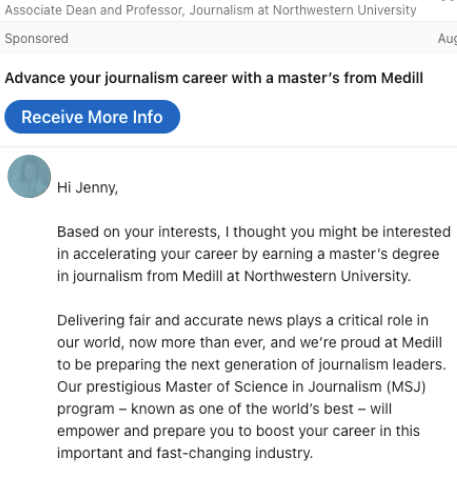
Dynamic Ads
Dynamic ads allow you to personalize your ad for individual members of your audience. You can use 3 different ad formats:
- Follower Ad: This type of ad unit builds brand awareness and engagement by converting target audience members into engaged page followers.
- Spotlight Ad: The ad format gives you the ability to showcase products, services, content, and more to increase website traffic.
- Content Ad: This type of ad allows up to five tabs for different types of content including video, brochures, blog posts, case studies, and white papers to generate leads or drive content download conversions. This format is currently only available for manager accounts.
By using profile data, you can increase engagement and deliver a message tailored to the person's background. These ads are particularly useful for driving event registrations or showing off a new product. You can even attract new followers or more relevant job applicants using various personalization options.
Text Ads
Text ads are exactly how they sound. They feature an attention-grabbing headline, a description with a strong CTA, and an image that will appeal to your audience, not just your logo. These ads show up on the right-hand side or top of the LinkedIn desktop feed.
By using simple but effective text, you can raise brand awareness and drive leads. Your copy should be brief but full of useful information. Try to include numbers, percentages, and other notable information to attract more attention.
Optimizing the text of your ads is crucial for their success and is often a good place to start to nail down copy that converts for your marketing efforts as a whole. Text ads are also the quickest and easiest way to push a LinkedIn campaign live, taking mere minutes to create.
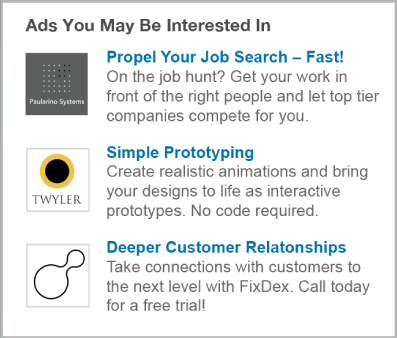
4. Write Ad Copy That Converts
To create a compelling ad design and copy, you must have a clear call to action. When developing your call to action, think about what the prospect is going to get out of clicking your ad. What issue does the user have and how can you help them solve it?
Your headline should clearly communicate the offer being featured in the ad, while the intro copy should state the problem, persona goal, and benefits.
By making your copy focused on what you are offering, you may get fewer clicks to your ad. However, the people who do click and go to the landing page have their expectations set correctly and will more likely convert to a lead. This keeps your LinkedIn ad costs down and your prospects qualified.
Landing Pages for LinkedIn Ads
A LinkedIn ad is a great tool to send traffic to your website — but after the user reaches your site, it's up to your landing page to get a user to take the desired action.
Landing pages must be designed with the user in mind and further optimized for increased performance. Landing page optimization is the process of enhancing or improving each element on your landing page to increase conversions. A simple design and straightforward copy are key to encouraging your customers and prospects to take desired actions.
Make sure when you are creating or optimizing your landing page that the offer and CTA are clear and above the fold, meaning the user does not have to scroll to see it. Don't be afraid to test different placements or form lengths. A good landing page design relies on user data and how they interact with your site, so it could take some time to perfect.
5. Set Your Budget
Your daily budget is the maximum amount you are willing to spend on a given day on your ad campaign with the minimum budget set at $10 a day.
It’s important to know that your daily spend could potentially be up to 20% higher due to the short amount of time it takes between hitting your daily spend and the point where your ads are no longer surfacing. A good rule of thumb when determining your daily budget is to multiply your bid by the number of clicks/impressions you'd like to get per day.
LinkedIn allows you to choose between two options when selecting your bid:
- Automated bidding: This type of bidding charges by impression. This is recommended, especially when just starting out, to get the most out of your budget.
- Maximum bidding: This bid type gives you more control over your budget by allowing you to define the maximum amount you would like to pay per click, per 1,000 impressions, or per video view. When choosing maximum spending, LinkedIn will show you a recommended bid as well as a range of prices that other advertisers are bidding for a similar targeted audience.
When setting your bid, you can select between:
- Cost Per Send (CPS): You only pay for each message that is delivered, usually within message ads.
- Cost Per View (CPV): You pay every time your video ad gets played.
- Cost Per Click (CPC): You pay a certain amount every time your ad is clicked. This method is best for action-oriented campaigns.
- Cost-Per-Impression (CPM): CPM stands for cost per mille with "mille" referring to every 1,000 impressions. In this method, you pay a certain amount for a network to serve up your ad 1,000 times with the price remaining the same whether people click to your website or not. This method is usually used for brand awareness campaigns.
After selecting one of the four, you will enter a suggested bid, daily budget, start date, end date, and total budget. Keep in mind that you can always go back and cancel or adjust your campaign as needed.
6. Measure and Optimize
Determine key metrics such as clicks, impressions, and click-through rate (CTR) based on the objective you have set for your campaign. When driving leads and conversions, you’ll want to look at how many people completed a desired action such as email signup, download, or purchase. Important metrics to consider are:
- Conversions: The number of times a user took an action after seeing or clicking on your ad. This metric is only used for campaigns with conversion tracking set up.
- Conversion rate: How often your ads result in conversions on your website.
- Cost per conversion: Ad spend divided by conversions.
- Leads: The number of leads you get from your ads. This metric is used for campaigns featuring LinkedIn Lead Gen Forms.
- Cost Per Lead (CPL): Ad spend divided by leads.
Tracking these metrics and then making adjustments to your ad campaign is key to finding success with LinkedIn advertising. You can edit ads, adjust your budget, and refine your targeting for better results.
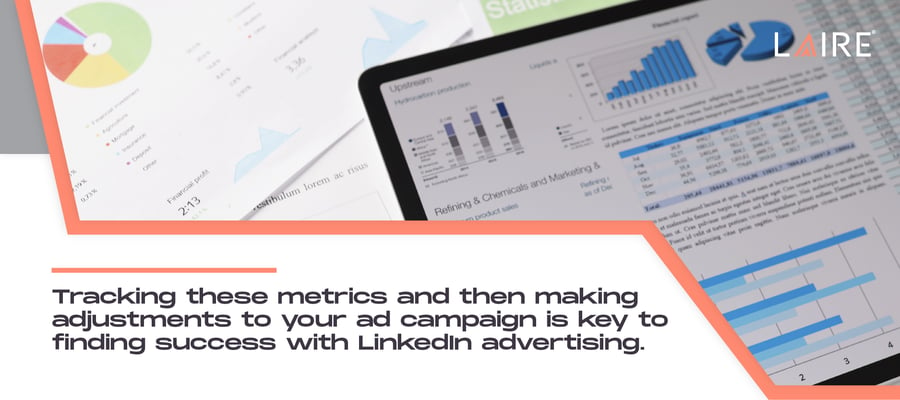
Tracking Clicks to Your Website
Good data insights come from proper data tracking. To track clicks to your website, make sure to add your ad's link with the UTM parameters attached.
UTM parameters are five tags you can add to the end of the URLs in your marketing efforts, allowing analytics software to track information to that specific landing page destination. These are particularly useful when determining which channels are most successful in driving site traffic or testing different ad designs. The five UTM tags are:
- Source: Used to show which platform the visitor came from.
- Medium: Used to show which marketing channels brought the visitor to your site such as email, social, or cost-per-click.
- Campaign: Used to identify which campaign the promotion is associated with.
- Term: Used to identify targeted paid keywords from your campaign.
- Content: Used to locate the exact section or part of your ad that was clicked. This is mainly used for optimization purposes.
UTM parameters are extremely useful in providing insight into what efforts are bringing in site traffic and how to determine if a campaign was successful or needs more work. There are several tools available to help you create links with UTM parameters, such as HubSpot's tracking URL builder.
Here is an example UTM parameter for two ad set designs:
- https://www.lairedigital.com/construction-marketing-checklist?utm_campaign=OFFER-ConstructionMarketingChecklist&utm_source=linkedin&utm_medium=paidsocial&utm_content=dark-background
- https://www.lairedigital.com/construction-marketing-checklist?utm_campaign=OFFER-ConstructionMarketingChecklist&utm_source=linkedin&utm_medium=paidsocial&utm_content=light-background
Notice the bold in the links above. This is to distinguish the two ads so that in reporting, we know which ad generated more leads or clicks to the landing page.
LAIRE LinkedIn Ad Spotlight
At LAIRE, we’ve had a lot of success with our manufacturer marketing checklist. We built a checklist that is specific to the marketing professionals of the manufacturing industry and then targeted our campaign toward manufacturing business owners and marketers.
LinkedIn advertising is great because while there is not a clearly defined industry for this segment, you can find other ways to target your market — in this case, toward skills that professionals have added to their profile.

Keep in mind that if you create a campaign like this, you might not get leads if you don’t have a compelling offer that resonates with your target market. On the image, make sure to have a button, describe what the offer is, and create an image of the book, checklist, or person.
Master the Art of How to Create a LinkedIn Ad
It may take much testing and optimizing to get your ad right. If you don't get the results you want, make sure to ask yourself these important questions before calling your campaign a fail:
- Are you targeting the right audience in your campaign settings?
- Are you clearly defining the problem in the ad design copy?
- Did you get many clicks to your ad but no conversions? This doesn’t mean your experiment was a failure. You have gained interest and now you need to make your landing page more effective.
Remember, social media platforms are always changing. If LinkedIn changes its algorithm or we find more successful endeavors in LinkedIn advertising, we'll be sure to let you know. Make sure you subscribe to our blog to never miss an update.

